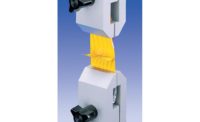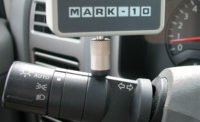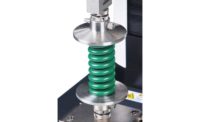The objective of materials testing is to measure characteristics and behaviors of materials under a number of conditions. Tests are performed to verify material characteristics such as:
- Tensile strength
- Compressive strength
- Flexure/Bend strength
- Peel strength
- Coefficient of friction
- Adhesion strength
- Shear Strength
- Puncture/Tear
- Delamination strength
- Bond/Adhesion strength
- Deformation strength
- Crush resistance
- Elongation
- Young’s Modulus
- Ductility
- Creep/Stress relaxation
- Elastic limit
- Torsion
Why conduct these tests? There are many reasons to perform materials tests. Data from testing can be used by engineers, scientists, designers, and managers. Here are the top five reasons for performing materials tests:
- Ensuring product and consumer safety
- Ensuring compliance
- Material selection
- Product design/improvement
- Quality validation
Ensuring product and consumer safety
By understanding material properties, engineers can confidently specify materials and assemblies that meet safety and durability requirements. The results of materials testing provide guidance for required margin of safety, thereby helping avoid product defects. Defects can cause relatively benign consequences such as harm to a company’s reputation, but can also cause physical injury to end users.
Ensuring compliance
As regulatory bodies and governments continuously add compliance requirements, products must be tested according to methods specified within these standards. More jurisdictions are adopting legislation requiring companies to declare their products’ material and chemical composition, and restricting the use of hazardous materials. Companies must adhere to specifications from sources such as ISO, ASTM, and DIN. These standards often specify the test procedure as well as the parameters for operating the test equipment. In industry, non-compliance can lead to penalties and restrict market access. In applications where international standards are not available or not applicable, companies sometimes develop their own standards and processes to establish baseline quality metrics.
Material selection
Specifying the appropriate material is often critical to the quality of a manufactured product. Materials testing can help us understand whether a particular material should undergo a specific treatment or process. Materials testing also ensures the suitability of a material for a given application.
Product design/improvement
Smarter, lighter, faster, better—design requirements push the limits of continuous improvement. Even engineers can become stressed and strained with new demands for better products. Product improvement requires constant testing and evaluation, but employing materials testing in the design process can provide the engineer with the information necessary for a particular application. Failure analysis simulation is a great tool which speeds up the prototyping process. When quantifiable material properties are identified and specified to suppliers, manufacturers can reasonably expect a lower rate of defects and failures.
Quality validation
The quality and reliability of products is frequently assessed through materials testing. The role of the quality department includes ensuring a product is manufactured in conformance with international or industry standards, verifying supplier specifications, providing traceable results, and demonstrating the performance of a material or product.
How Can We Test Materials?
Materials testing systems can be configured for a variety of applications by choosing the appropriate components. The components that make up a materials test system:
- Test frame
- Load cell
- Distance measuring device
- Data collection software
- Test fixtures and grips
- Safety enclosure
Test frame
An electromechanical test frame applies a tension or compression force necessary to achieve the test’s objective. Single column testers are typically employed for applications requiring lower forces, generally up to 1,000 – 2,000 lbF (5 – 10 kN). Single column testers are suitable for bench mounting and can be used in a lab or production environment.
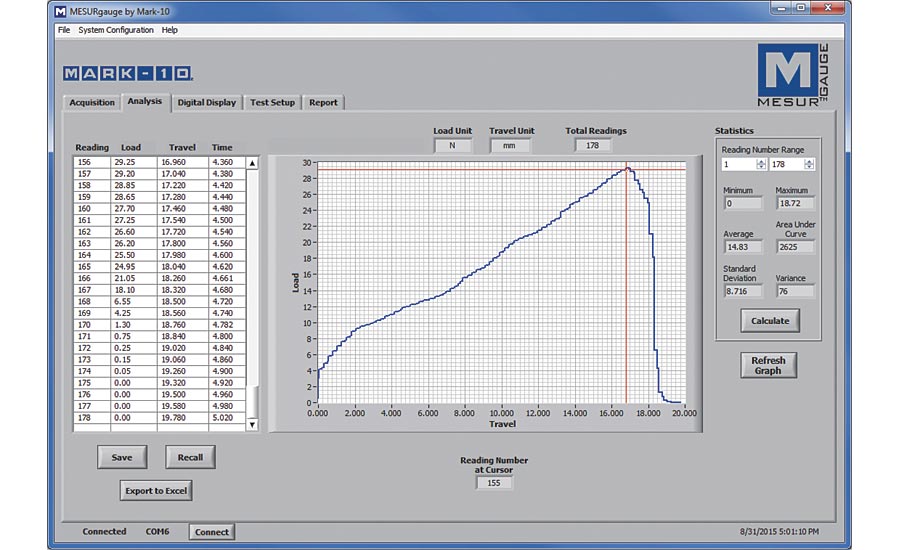
Data collection software provides insight into the behavior of a material, component, or assembly when subjected to tension or compression loads.
Double column testers can be used in some low force applications, but higher costs of ownership typically relegate them to applications of 5,000 lbF (25 kN) and higher. A double column test frame can be configured for bench mounting or floor mounting. Floor mounted testers are typically more robust, designed for heavy duty testing. Test frames are often driven by one or two lead screws, while heavy duty machines are actuated hydraulically. Customized test frames may be necessary to accommodate large samples or samples with high elongation properties.
Load cell
A load cell is at the heart of any force or materials testing system. Strain-gage based load cells are the industry norm, converting force into an electrical signal. Strain gages applied to a deformable element bend when weight or force is applied. Small changes in resistance occur as the gages deform, resulting in a signal that can be processed and converted into digital form. The result is presented in terms of force units such as lbF, kgF, or N.
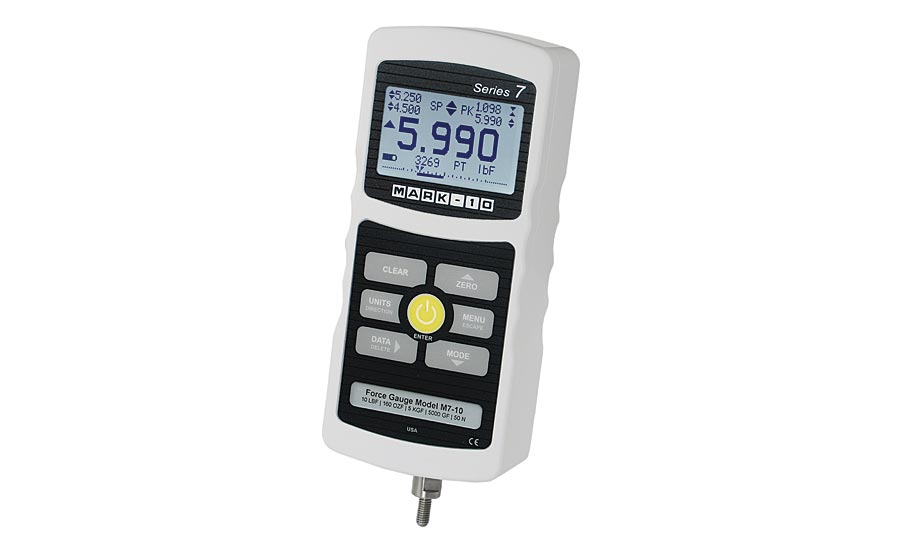
A force gage integrates a load cell and indicator into one enclosure, and is commonly used on test frames in applications up to 500 lbF (2.5 kN).
A load cell is often integrated into a force gage in some basic materials testing systems. A force gage is a single instrument that combines the function of a load cell with that of an indicator, or read-out device.
It is important to choose a load cell or force gage with a measurement capacity as close as possible to the anticipated loads. For optimal accuracy and lowered risk of overload, it’s recommended to use a load cell between 10% and 90% of its range. Load cells often have mechanical overload protection to 200% of the published range, but it is still not recommended to exceed 100%.
Distance measuring device
A means of measuring distance, extension, or deformation is often required, in addition to measuring force. For those applications, an integrated encoder or linear scale can be employed to measure the travel or response of the sample to the movement of the crosshead of the test frame. In the case of small deflections, an extensometer is better suited, as it provides more accurate measurement and better resolution. Extensometers clamp on to the sample or use a camera or laser to measure deformation directly on the sample, thereby eliminating any errors introduced from bending and mechanical play in the test frame and load cell.
Data collection software
As data is captured, a means of providing the test results is needed. In older systems, a result was simply read from a display screen or gage. Today’s sophisticated systems enable results to be sent to a PC and presented through data collection software in charts, graphs, and reports. Typical graphs include representations of force vs. distance or stress vs. strain. Spring rate, Young’s Modulus, and other parameters can be extrapolated for further analysis. Trends include the integration of analysis and control software, automatic calculation of material properties, data overlay, and simple touch-screen user interface.
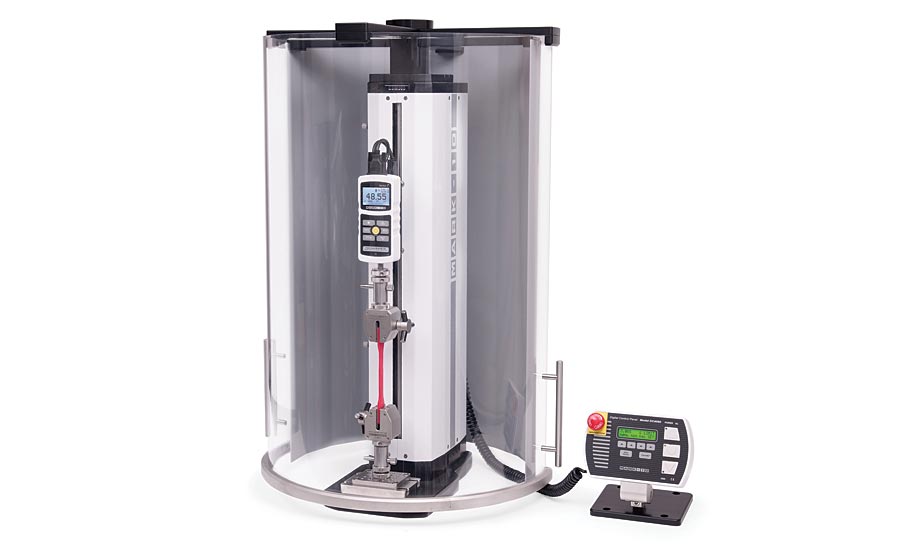
A safety enclosure is recommended in many applications, providing pinch and airborne sample debris protection. Door interlocks prevent the test frame from being used while the door is open.
Test fixtures & grips
As applications continue to grow, numerous fixtures, attachments, buttons, probes, and grips have been developed. Test sample holding solutions include wedge grips for rigid metal or plastic samples, parallel jaw grips for fabrics and films or semi-rigid materials, pneumatic grips for fast clamping, compression plates for springs and foams, bollard grips for ropes and wires, and many more. Specialized fixtures are available for 3 and 4-point bend, coefficient of friction, peel, and crimp pull applications. Non-standard applications can be addressed by creating custom grips or fixtures, nowadays often with a 3D printer for low force applications.
Safety enclosure
Test systems are often enclosed with a safety shield to protect the operator from flying samples or debris. Additionally, some materials testing systems are available with environmental chambers that allow for the testing of materials across a wide range of temperature, humidity and caustic conditions.
Materials testing can improve products and contribute to our health, happiness, and safety. New materials add to the vast menu of possibilities available to engineers in the design process. The result has been products which are better, cheaper, and safer, for the benefit of humankind. Q

